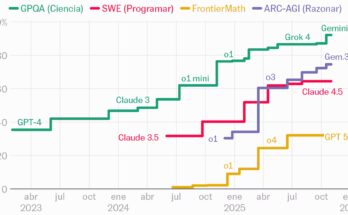Alpine newts are born and live as larvae in pools, ponds or streams. After metamorphosis and still young, they leave the water and spend almost the whole year in the thick humid forests of Europe. But when the time comes to mate, they return to the same pool where they were born. To assess their sense of direction, some of them traveled up to 42 kilometers away from their pond. And they immediately returned home, without problems, with their only 12 centimeters in size. Like many other animals, these amphibians sense the Earth’s magnetic field, which acts as a compass and GPS, to know their position on Earth and be able to return to it. But we humans are still beginning to understand this superpower.
“The Earth’s magnetic field permeates us all,” recalls Francisco Javier Diego-Rasilla, of the Spanish Herpetological Association, at the National Museum of Natural Sciences. “But the magnetic sense, unlike the other senses, is the most elusive of all,” he adds. Amphibians such as newts and frogs are known to sense the planet’s magnetism. It has also been documented in at least 20 species of birds and not just migratory ones. Among fish, rays and sharks they orient themselves thanks to magnetic polarity. In reptiles, sea turtles are believed to return to the beach where they were born because a mental map with coordinates is fixed in their brain. Some mammals, especially bats and mice, also rely on magnetism to fly at night or move underground in complete darkness.
But it is one thing to know that many animals have this magnetic sense and another to identify its mechanism. There is not, or at least has not yet been found, a specific organ for perceiving the magnetic field, as the nose or hands are for smell or touch. In the retina of migratory birds they have located proteins, cryptochromes, sensitive to blue light: they are the first step of a complex orientation mechanism based on quantum physics. Loggerhead sea turtles are believed to have particles of magnetite, a magnetic mineral, somewhere in their bodies, which they generate internally. And amphibians have a key gland inside their head for orientation.
“You have to know where you are going, but also where you are,” says Diego-Rasilla. That is to say, a compass pointing north is not enough to guide you. You also need a map as a starting point. “There are tasks, such as moving on a perpendicular axis, going towards the edge of the pond, for which the compass is sufficient,” adds the researcher, who has been studying the magnetic sense of amphibians for decades. “But Alpine newts, which migrate at night, use a mental map for their migrations in addition to the compass,” he adds. On this map they keep the coordinates that allow them to return. What Diego-Rasilla discovered after years of experiments, capturing these newts (Ichthyosaura alpestris) and take them away, is that they recalibrate the compass by updating the map every day: just when the Sun sets they align on a north-south axis, but slightly deviated towards the east, “and just when there are fewer disturbances in the magnetic field”, recalls the researcher.
When in the 1960s two German ornithologists, W. Merkel and W. Wiltschko, discovered that European robins flew from northern Europe to Africa thanks to magnetoreception, skepticism among their colleagues was the norm. And their experiments were rigorous: released into elongated cages surrounded by Helmholtz coils, which generate their own magnetic field, canceling out others (such as the Earth’s), the birds readjusted their flight depending on the new field.
However, the evidence was piling up. It was soon discovered that what guides the birds is not just the polarity of the field (magnetic north), but its intensity. Earth’s magnetic field is due to the presence of a partially molten iron core in a rotating planet. It is, as elementary school students are taught, a gigantic electromagnet. The avian compass, which does not work like those made by humans, would rely on magnetite nanoparticles found in the beak to sense the strength of the magnet.
There is another possible mechanism that is not yet fully understood: the perception of the inclination of the field is detected by robins and other birds thanks to photosensitive molecules in their eyes, especially in the right one. These cryptochromes trigger a biochemical process with effects typical of quantum physics: they form pairs of free radicals, where the electrons that behave according to the magnetic field are not paired.
Wireless in-ear charger
But pigeons seem to orient themselves differently. No magnetite was found in them and they can orient themselves in complete darkness. In a work recently published in Sciencea group of scientists has managed to discover the neuronal and molecular mechanism with which they perceive the Earth’s magnetic field following another principle, that of magnetic induction. “It’s the same one used in wireless chargers,” compares Gregory Nordmann, of the Max Planck Institute for Biological Intelligence and the University of Munich (Germany).
“When a magnetic field changes, it produces an electric current in a conductor. In pigeon navigation, the magnetic field does not move; it is the bird that does it. When it flies or turns its head, it moves through the Earth’s magnetic field, and this movement induces small electrical signals in the semicircular canals of the inner ear,” explains Nordmann. “A set of specialized electrosensory cells detect these signals: they capture the induced currents and send the information to the brain, providing the pigeon with a reliable and light-independent compass,” completes the German scientist.
The mechanism confirmed in pigeons, the same one believed to be used by elasmobranchs such as rays and sharks, brings the so far known systems by which animals guide themselves to three: magnetite nanocrystals, light-dependent quantum biochemistry and magnetic induction. “This suggests that magnetoreception has evolved convergently; that is, different species, with different anatomies and ecological needs, have developed similar sensory capabilities through different biological mechanisms,” Nordmann bets.
Perhaps the most fascinating case of magnetic sense is that of loggerhead turtles (Caretta caretta). The hatchlings emerge from the sand, move towards the sea and, after having traveled thousands of kilometers after 20-30 years, return to the same beach to lay their eggs. In a recent experiment, a group of researchers interfered with their magnetic perception. Although collected on the coast of North Carolina (United States), they were fed for eight months while a magnetic pulse made them feel the magnetic field that existed much further south, in Haiti or the Turks and Caicos Islands (overseas territory of the United Kingdom). They then tried to condition them in the style of Pavlov’s work with dogs, so that they would associate the magnetic coordinates with the food reward.
Once conditioned, they attempted to “make them magnetically blind” before virtually placing them again on one of the Caribbean islands. The little ones stopped showing joy before they became disoriented. This would indicate the presence of magnetite inside.
“It has been proposed that animals’ sense of magnetic orientation could involve biochemical reactions influenced by the Earth’s magnetic field,” Alayna Mackiewicz, a researcher at the University of North Carolina at Chapel Hill and first author of this work, published in Journal of Experimental Biology. “Since the proposed chemical reactions are temporary, a magnetic pulse should not have a lasting effect,” the researcher emphasizes. “Instead, the magnetite crystals are likely embedded in specialized sensory cells, and the magnetic pulse could remagnetize these tiny magnets and thus alter the magnetic information sent to the nervous system,” he adds.
The magnetite may be what connected them to the beach where they were born. Thanks to these nanocrystals, their coordinates would be fixed in their brain just before diving into the sea. Mackiewicz sums it up this way: “There is evidence to support the geomagnetic imprinting hypothesis in sea turtles, where individuals identify with the magnetic field of their birthplace and use this information to return to their natal beaches.” But he ends up admitting that “the exact mechanism is not known, but it is likely that they use magnetic information to orient themselves when they return to their place of origin.”



